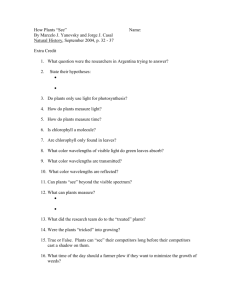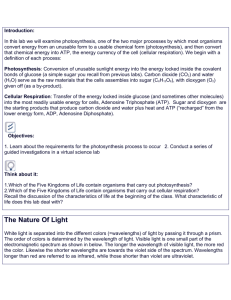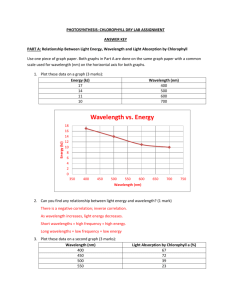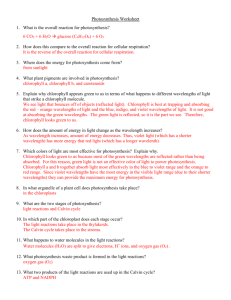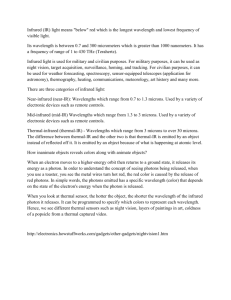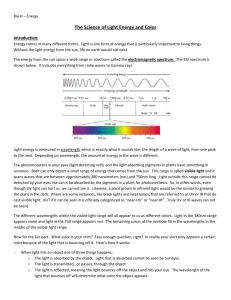Abstract
advertisement
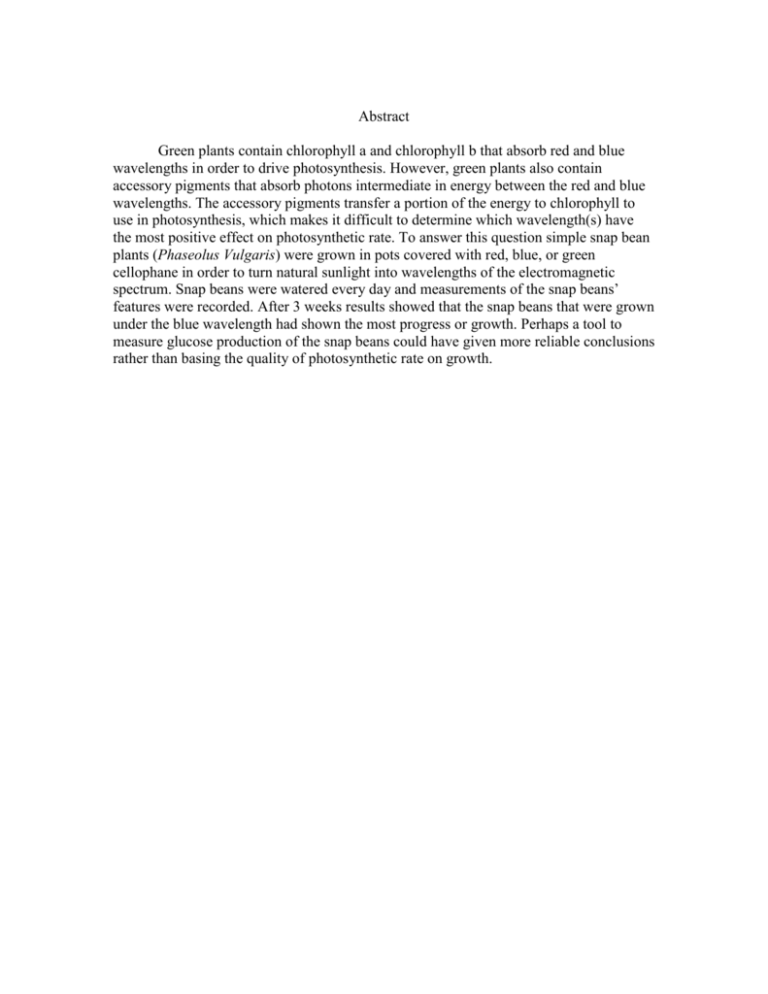
Abstract Green plants contain chlorophyll a and chlorophyll b that absorb red and blue wavelengths in order to drive photosynthesis. However, green plants also contain accessory pigments that absorb photons intermediate in energy between the red and blue wavelengths. The accessory pigments transfer a portion of the energy to chlorophyll to use in photosynthesis, which makes it difficult to determine which wavelength(s) have the most positive effect on photosynthetic rate. To answer this question simple snap bean plants (Phaseolus Vulgaris) were grown in pots covered with red, blue, or green cellophane in order to turn natural sunlight into wavelengths of the electromagnetic spectrum. Snap beans were watered every day and measurements of the snap beans’ features were recorded. After 3 weeks results showed that the snap beans that were grown under the blue wavelength had shown the most progress or growth. Perhaps a tool to measure glucose production of the snap beans could have given more reliable conclusions rather than basing the quality of photosynthetic rate on growth. Introduction Light is the main component of photosynthesis. Light comes in the form of discrete packets called photons. Not only does light come in the form of photons, but light also comes in the form of wavelengths. Wavelengths emit different colors and are arranged based on decreasing energy per photon in the electromagnetic spectrum. The shortest wavelength is violet and the longest wavelength is red. Shorter wavelengths have more energy than longer wavelengths. Pigments absorb photons and put pigments in an excited state. Photosynthesis uses the pigments chlorophyll a and b to absorb photons. Chlorophyll a and b only absorb red and blue wavelengths but they are not the only pigments associated with photosynthesis. All photosynthetic organisms also contain accessory pigments that absorb photons intermediate in energy between red and blue wavelengths. Since green plants absorb red, blue, and all those wavelengths in between there was much questioning on which wavelength had the greatest impact on photosynthesis. Much of this question may be answered by knowing what type of accessory pigment the green plant has. For example, the accessory pigments called carotenoids absorb photons in blue and bluegreen wavelengths. Phycobilins absorb yellow-green, yellow, and orange wavelengths. An experiment performed by four botanists working for Advanced Life Support and Space Biology tested the effectiveness of a supplement of blue light added to existing red light and tested the effect it had on seed yield of wheat plants. Their results read: “that wheat can complete its life cycle under red LEDs alone, but larger plants and greater amounts of seed are produced in the presence of red LEDs supplemented with a quantity of blue light.” Before there is any more analyzing into photosynthetic rate and the impact of wavelength the effects that light in take has on photosynthesis must be understood. Energy is conserved in photosynthesis when the excited chlorophyll molecule (after absorption of a photon) is in the reaction center and is used as a reducing agent. In lamest terms, the chlorophyll absorbs light in the chloroplast when excited pigmented molecules pass energy to other pigmented molecules in order to reduce the excited pigmented molecules. The chlorophyll participates in a redox reaction that could not have taken place in the dark. These reducing chlorophyll molecules may be found in either Photo system I or Photo system II. There are millions of types of green plants but Snap beans are the best-known garden plants in the United States. They are annual plants that have a bush type growth habit. They can easily be grown in warm weather and their leaves have three leaflets making them good candidates for our experiment. Zelena in 1999 observed the effect of the presence and absence of light on metabolism of IAA Ca type of acetic acid in maize seedling; furthermore, she was able to observe the effects of light on seedling and individual tissue growth. Both seedlings and individual tissues were exposed to light for different amounts of time (or no light at all) before continuing on to determine the amount of IAA present. It was found that light caused IAA to be metabolized faster, therefore decreasing growth in plant tissues. Light inhibition was found to stimulate growth (After the addition of IAA). Another similar experiment tested the effect of light and darkness in pod development of peanut plants (Shlamovitz et al.,1993). This experiment was performed on the gynophores and pods of peanut plants in the complete presence or absence of light. It was observed that gynophores elongated in light, but not in darkness due to a decrease in cell division. However, pod development could be controlled by changing light conditions. In a different experiment (Rivadossi.et al. 1999) tested the importance of red forms of PS I chlorophyll in light harvesting by leaves. It was found that “while the PS I red forms account for only about 4-5% of light absorption in a normal ‘daylight’ environment, in different ‘shade light’ environments these long wavelength pigments may be responsible for up to 40% of photon capture.” This experiment demonstrates the effect of light absorption on the dark reaction. As the world of agriculture continues to grow, farmers often search for alternative methods of harvesting crops that might lead to greater production. Since it is already known that chlorophyll absorb only specific wavelengths there is no need for speculation that green plants have a tendency to have more positive photosynthetic rates under specific wavelengths. The question to address is to which wavelength would be most effecient toward progressive photosynthetic rate? In the light spectrum blue seems to be the most likely because it is the shortest wavelength and has the greatest amount of energy, but longer wavelengths have a deeper effect on the dark reactions that occur in photosynthesis. In the following experiment we will explore which wavelengths, long, short, or mediocre will produce the most growth and nutrition. Hypothesis/Prediction The blue wavelength will produce the most growth in phaseolus vulgaris because blue wavelengths are the shortest wavelengths that green plants absorb and contain the most energy. If we plant 4 groups of phaseolus vulgaris (snap beans) with 4 plants in each group under red, blue, green, and normal sunlight wavelengths, then the group of plants under the blue wavelength will show evidence of the greatest amount of photosynthetic growth. Bibliography Goins, Yorio, Sanwo, and Brown. 1997. Photomorphogenesis, photosynthesis, and seed yield of wheat plants grown under red light-emitting diodes (LEDs) with and without supplementary blue lighting. Journal of Experimental Botany 48:1407-1413. Rivadossi, Zucchelli, Garlaschi, and Jennings. 1999. The importance of PS I chlorophyll red forms in light harvesting by leaves. Photosynthesis Research 60: 209-215. Shlamovitz, Neomi, Ziv, Meira, Zamski, Eli. 1995. Light, dark, and growth regulator involvement in groundnut (Arachis hypogaeal.) pod development. Journal of Plant Growth Regulation 16: 37-42. Zelena, Eva. 2000. The effect of light and metabolism of IAA in maize seedlings. Journal of Plant Growth Regulation 30: 23-29. Xie, H.S., Hsiao, A.I, and Quick W.A.. 1996. Influence of Temperature and light intensity and absorption, translocation, and phytotoxiaty of fenoxaprop-ethyl and imazamethabenz-methal in Avvena Fatua. Journal of Plant Growth Regulation 15; 5762. Purves, William K, Orians, Gordon H, Heller, Craig H, Sadava, David. Life: The Science of Biology. Courier Companies, Inc. 1999. South, Salt Lake City, Utah. Pgs 168-172.
